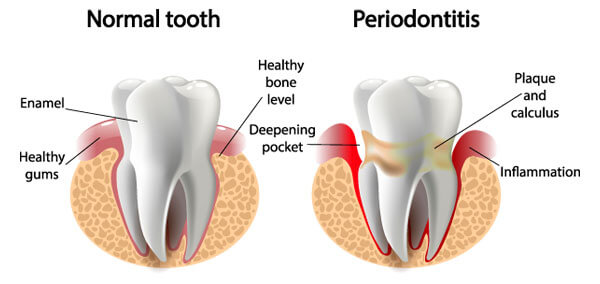
Whittier Dental Arts
The Art of dentistry in Whittier
Periodontics in Whittier, CA
What is Periodontal (Gum) Disease?

The term “periodontal” means “around the tooth.” Periodontal disease (also known as Periodontitis and gum disease) is a common inflammatory condition which affects the supporting and surrounding soft tissues of the tooth; also the jawbone itself when in its most advanced stages.
Periodontal disease is most often preceded by gingivitis which is a bacterial infection of the gum tissue. A bacterial infection affects the gums when the toxins contained in plaque begin to irritate and inflame the gum tissues. Once this bacterial infection colonizes in the gum pockets between the teeth, it becomes much more difficult to remove and treat. Periodontal disease is a progressive condition that eventually leads to the destruction of the connective tissue and jawbone. If left untreated, it can lead to shifting teeth, loose teeth and eventually tooth loss.
Periodontal disease is the leading cause of tooth loss among adults in the developed world and should always be promptly treated.
Periodontal disease is most often preceded by gingivitis which is a bacterial infection of the gum tissue. A bacterial infection affects the gums when the toxins contained in plaque begin to irritate and inflame the gum tissues. Once this bacterial infection colonizes in the gum pockets between the teeth, it becomes much more difficult to remove and treat. Periodontal disease is a progressive condition that eventually leads to the destruction of the connective tissue and jawbone. If left untreated, it can lead to shifting teeth, loose teeth and eventually tooth loss.
Periodontal disease is the leading cause of tooth loss among adults in the developed world and should always be promptly treated.
Periodontal Disease Prevention
Periodontal diseases destroy the support of your natural teeth. There are numerous disease entities requiring different treatment approaches. Dental plaque is the primary cause of gum disease in genetically susceptible individuals. Daily brushing and flossing will prevent most periodontal conditions.
Why is oral hygiene so important? Adults past the age of 35 lose more teeth to gum diseases, (Periodontal Disease) than from cavities. Three out of four adults are affected at some time in their life. The best way to prevent cavities and Periodontal Diseases is by good tooth brushing and flossing techniques, performed daily.
Periodontal disease and decay are both caused by bacterial plaque. Plaque is a colorless film, which sticks to your teeth at the gum line. Plaque constantly forms on your teeth. By thorough daily brushing and flossing you can remove these germs and help prevent periodontal disease.
Why is oral hygiene so important? Adults past the age of 35 lose more teeth to gum diseases, (Periodontal Disease) than from cavities. Three out of four adults are affected at some time in their life. The best way to prevent cavities and Periodontal Diseases is by good tooth brushing and flossing techniques, performed daily.
Periodontal disease and decay are both caused by bacterial plaque. Plaque is a colorless film, which sticks to your teeth at the gum line. Plaque constantly forms on your teeth. By thorough daily brushing and flossing you can remove these germs and help prevent periodontal disease.
Types of Periodontal Disease
When left untreated, gingivitis (mild gum inflammation) can spread to below the gum line. When the gums become irritated by the toxins contained in plaque, a chronic inflammatory response causes the body to break down and destroy its own bone and soft tissue. There may be little or no symptoms as periodontal disease causes the teeth to separate from the infected gum tissue. Deepening pockets between the gums and teeth are generally indicative that soft tissue and bone is being destroyed by periodontal disease.
Here are some of the most common types of periodontal disease:
- Chronic Periodontitis – Inflammation within supporting tissues cause deep pockets and gum recession. It may appear the teeth are lengthening, but in actuality, the gums (gingiva) are receding. This is the most common form of periodontal disease and is characterized by progressive loss of attachment, interspersed with periods of rapid progression.
- Aggressive Periodontitis – This form of gum disease occurs in an otherwise clinically healthy individual. It is characterized by rapid loss of gum attachment, chronic bone destruction and familial aggregation.
- Necrotizing Periodontitis – This form of periodontal disease most often occurs in individuals suffering from systemic conditions such as HIV, immunosuppression and malnutrition. Necrosis (tissue death) occurs in the periodontal ligament, alveolar bone and gingival tissues.
- Periodontitis caused by systemic disease – This form of gum disease often begins at an early age. Medical condition such as respiratory disease, diabetes and heart disease are common cofactors.
Common Signs & Symptoms of Periodontal Disease
It is extremely important to note that periodontal disease can progress without any signs or symptoms such as pain. This is why regular dental checkups are exceptionally important. Described below are some of the most common signs and symptoms of periodontitis.
Dr. Gutierrez strongly advices the patients to schedule an appointment for evaluation, if you have any of these signs or symptoms
Dr. Gutierrez strongly advices the patients to schedule an appointment for evaluation, if you have any of these signs or symptoms
- Unexplained bleeding – Bleeding when brushing, flossing or eating food is one of the most common symptoms of a periodontal infection. The toxins in plaque cause a bacterial infection which makes the tissues prone to bleeding.
- Pain, redness or swelling – A periodontal infection may be present if the gums are swollen, red or painful for no apparent reason. It is essential to halt the progression of the infection before the gum tissue and jaw bone have been affected. It is also critical to treat the infection before it is carried into the bloodstream to other areas of the body.
- Longer-looking teeth – Periodontal disease can lead to gum recession. The toxins produced by bacteria can destroy the supporting tissue and bones, thus making the teeth look longer and the smile appear more “toothy.”
- Bad breath/halitosis – Although breath odor can originate from back of the tongue, the lungs and stomach, from the food we consume, or from tobacco use, bad breath may be caused by old food particles which sit between the teeth and underneath the gum line. The deeper gum pockets are able to house more debris and bacteria, causing a foul odor.
- Loose teeth/change in bite pattern – A sign of rapidly progressing periodontitis is the loosening or shifting of the teeth in the affected area. As the bone tissue gets destroyed, teeth that were once firmly attached to the jawbone become loose or may shift in position.
- Loose teeth/change in bite pattern – A sign of rapidly progressing periodontitis is the loosening or shifting of the teeth in the affected area. As the bone tissue gets destroyed, teeth that were once firmly attached to the jawbone become loose or may shift in position.
- Pus – Pus oozing from between the teeth is a definitive sign that a periodontal infection is in progress. The pus is a result of the body trying to fight the bacterial infection.
Treatment of Periodontal Disease
It is of paramount importance to halt the progression of periodontal disease before it causes further damage to the gum tissues and jawbone. At Whittier Dental Arts we will initially assess the whole mouth in order to ascertain the progress of the disease. After a thorough dental examination Dr. Gutierrez presents the patient with a customized treatment plan to address and treat the patient’s specific needs.
In the case of moderate periodontal disease, the pockets (under the gum line) of the teeth will be completely cleared of debris using a procedure called scaling and root planning. The pockets may be filled with antibiotics to promote good healing and kill any bacteria that remain.
Severe periodontitis can be treated in several different ways, such as:
In the case of moderate periodontal disease, the pockets (under the gum line) of the teeth will be completely cleared of debris using a procedure called scaling and root planning. The pockets may be filled with antibiotics to promote good healing and kill any bacteria that remain.
Severe periodontitis can be treated in several different ways, such as:
- Laser treatment – This can be used to reduce the size of the pockets between the teeth and the gums.
- Tissue & bone grafting – Where a considerable amount of bone or gum tissue has been destroyed, the dentist may elect to graft new tissue by inserting a membrane to stimulate tissue growth.
- Pocket elimination surgery – The dentist may choose to perform “flap surgery” to directly reduce the size of the gum pockets.
- Laser treatment – This can be used to reduce the size of the pockets between the teeth and the gums.
- Tissue & bone grafting – Where a considerable amount of bone or gum tissue has been destroyed, the dentist may elect to graft new tissue by inserting a membrane to stimulate tissue growth.
- Pocket elimination surgery – The dentist may choose to perform “flap surgery” to directly reduce the size of the gum pockets.
Healthy Smiles come from strong gums and bones. Regular visits with Dr. Gutierrez will maintain the health of these vital structures. Call Whittier Dental Arts for a consultation.
RELATED
-
 Root Canals
Root Canals
-
 Periodontics
Periodontics
-
 Minimally Invasive Dentistry
Minimally Invasive Dentistry
-
 Air Abrasion
Air Abrasion
VISIT WHITTIER DENTAL ARTS
Hours
Mon
9am – 6pm
Tue
9am – 6pm
Wed
9am – 6pm
Thu
9am – 6pm
Fri
9am – 6pm
Sat
8am – 2pm
By appointment only


5.0 Rating
Start Your Journey Today
(562) 907-6000
Call or complete this form
- General Inquiry
- Request Appointment
[ninja_form id=2]
[ninja_form id=3]